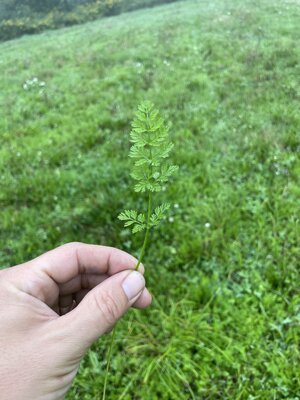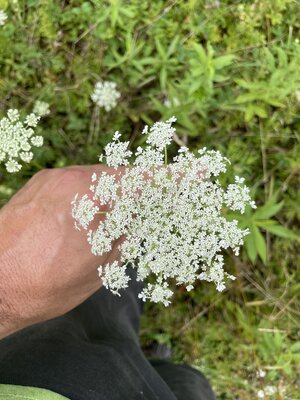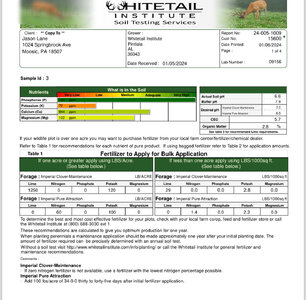-
The forum has been upgraded to support both light and dark themes. Click here for directions.
You are using an out of date browser. It may not display this or other websites correctly.
You should upgrade or use an alternative browser.
You should upgrade or use an alternative browser.
Sheperds needle
- Thread starter jlane35
- Start date
Native Hunter
Well-Known Member
I would say almost definitely it is in the carrot family, but I can't say for sure which specific plant species with only that picture. The identifying features of several species look nearly the same when they are that small. When it gets larger and develops inflorescence you should be able to easily tell.
jlane35
Well-Known Member
It was back again this year, so I made sure to grab a picture of its flower. The field is loaded with it. Should I go around with a trimmer and clip the tops?
I’m not broadcasting my fall seed for another 2-3 weeks.
This plot has been a no spray situation for 4-5 years and gets Green Cover’s fall release every year.
Should I be worried about this plant or just let the field continue to take its course?
I’m not broadcasting my fall seed for another 2-3 weeks.
This plot has been a no spray situation for 4-5 years and gets Green Cover’s fall release every year.
Should I be worried about this plant or just let the field continue to take its course?
Attachments
Native Hunter
Well-Known Member
I personally prefer to not let unwanted species go to seed.
MarkDarvin
Well-Known Member
Queen Anne's Lace.

 extension.psu.edu
extension.psu.edu

Wild Carrot or Queen Anne's Lace
Wild carrot or Queen Anne's lace (Daucus carota) is a biennial.
MarkDarvin
Well-Known Member
You can cut it before it goes to seed, and it's probably going to come back to some degree, but there are options to make it move out for good. Here are some non-lethal biological to change the environment that isThat makes sense why I didn’t see the white flowers last year!!!
The entire field is covered in them.
I’m contemplating cutting them or just letting them go for 2 more weeks when I plant. I’m not sure how fast the seeds mature.
1. Increase your P availability. You can do this a few different ways, and P fertilizer isn't one of them. Get your pH as close to 6.5 as possible.
2. Get into an always green rotation. This will raise your mycorhizal fungi population and that is the way to get P made available in your soil.
3. Increase calcium. Wild carrot is found in low calcium situations, so if your pH is already right, use gyspum to raise calcium.
4. Reduce your iron availability. Increased calcium will antagonize iron availability, so gypsum can kill two birds with one stone.
5. Raise your soil K levels. Step 2 will accomplish this. High residue high carbon crops like winter rye are also good for mining a shit ton of K that stays plant available.
Actual action items
Low pH: Add calcitic lime, get rye in there and stay green
Good pH: Add gypsum, get rye in there, and stay green
MarkDarvin
Well-Known Member
That one's free.
jlane35
Well-Known Member
You are a wizard. My K levels are extremely low. My PH is good. Im in a strictly throw and mow no spray situation every fall.
Gypsum it is. I’ll be going for some this week.
Should Gypsum be added to every plot if my K is low, which it is. And how much per acre is a good amount to start?
Gypsum it is. I’ll be going for some this week.
Should Gypsum be added to every plot if my K is low, which it is. And how much per acre is a good amount to start?
Attachments
Last edited:
MarkDarvin
Well-Known Member
You are a wizard. My K levels are extremely low. My PH is good. Im in a strictly throw and mow no spray situation every fall.
Gypsum it is. I’ll be going for some this week.
Should Gypsum be added to every plot if my K is low, which it is. And how much per acre is a good amount to start?
You are a wizard. My K levels are extremely low. My PH is good. Im in a strictly throw and mow no spray situation every fall.
Gypsum it is. I’ll be going for some this week.
Should Gypsum be added to every plot if my K is low, which it is. And how much per acre is a good amount to start?
You could certainly add some. You’ve got a pretty light soil, so it won’t hold a lot of excess potash. 100 lbs per acre potash about a month before rye surges in spring would be a good time to catch it.
Sent from my iPhone using Tapatalk
MarkDarvin
Well-Known Member
Oh hell, I didn't realize you asked about gypsum, and not potash.You are a wizard. My K levels are extremely low. My PH is good. Im in a strictly throw and mow no spray situation every fall.
Gypsum it is. I’ll be going for some this week.
Should Gypsum be added to every plot if my K is low, which it is. And how much per acre is a good amount to start?
It depends. I only have a couple acres of plots myself, and they are all different, so I can play with very high rates on very small spots. I'm not sure where the sweet spot would be for turning the corner. If the QAL isn't moving too fast, I might try mowing it for now, but segregate a few spots and try some different rates and see what happens. I also have low calcium, and I've had that weed show up, but it never went anywhere for me.
MarkDarvin
Well-Known Member
A little potash wouldn't hurt. The soil needs some chloride too.
One thing to consider: Soil tests are just a snap shot. If it was cold or dry, or cold and dry when you took your sample, you could show low K in a soil test. Also, have you seen any signs of a K deficiency? For simple purposes, if and when you let rye go to maturity, did your plants gets tall and thick and stand well?
One thing to consider: Soil tests are just a snap shot. If it was cold or dry, or cold and dry when you took your sample, you could show low K in a soil test. Also, have you seen any signs of a K deficiency? For simple purposes, if and when you let rye go to maturity, did your plants gets tall and thick and stand well?
MarkDarvin
Well-Known Member
Then I'd try a couple side by side test spots. Leave one spot with nothing, one with a 100 lb rate of 0-0-60, and another with a 200 lb rate of 0-0-60. That way you can see if it makes a difference before you buy a bunch of potash for the whole property.They did not get tall or thick. Very short and thin as compared to years past.




